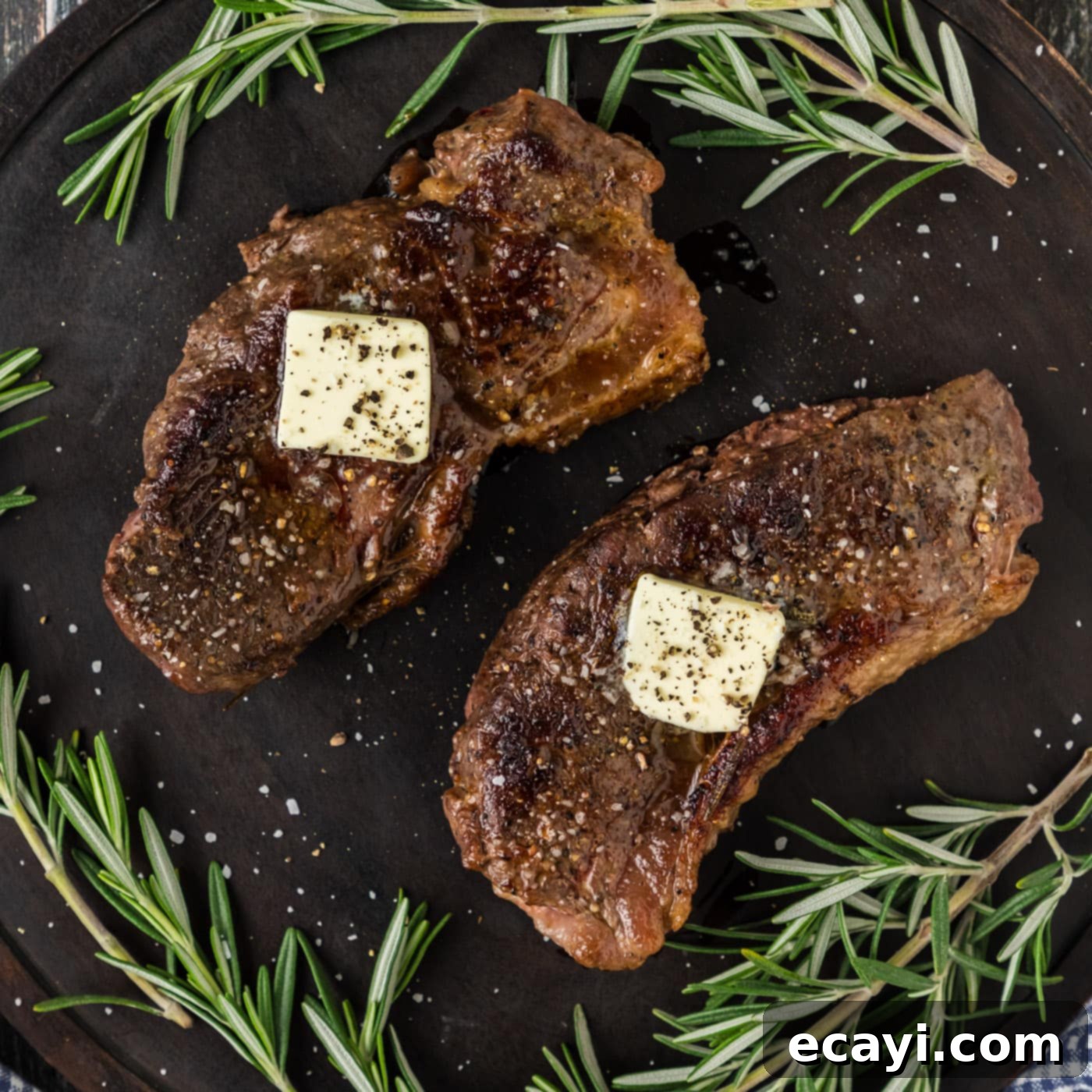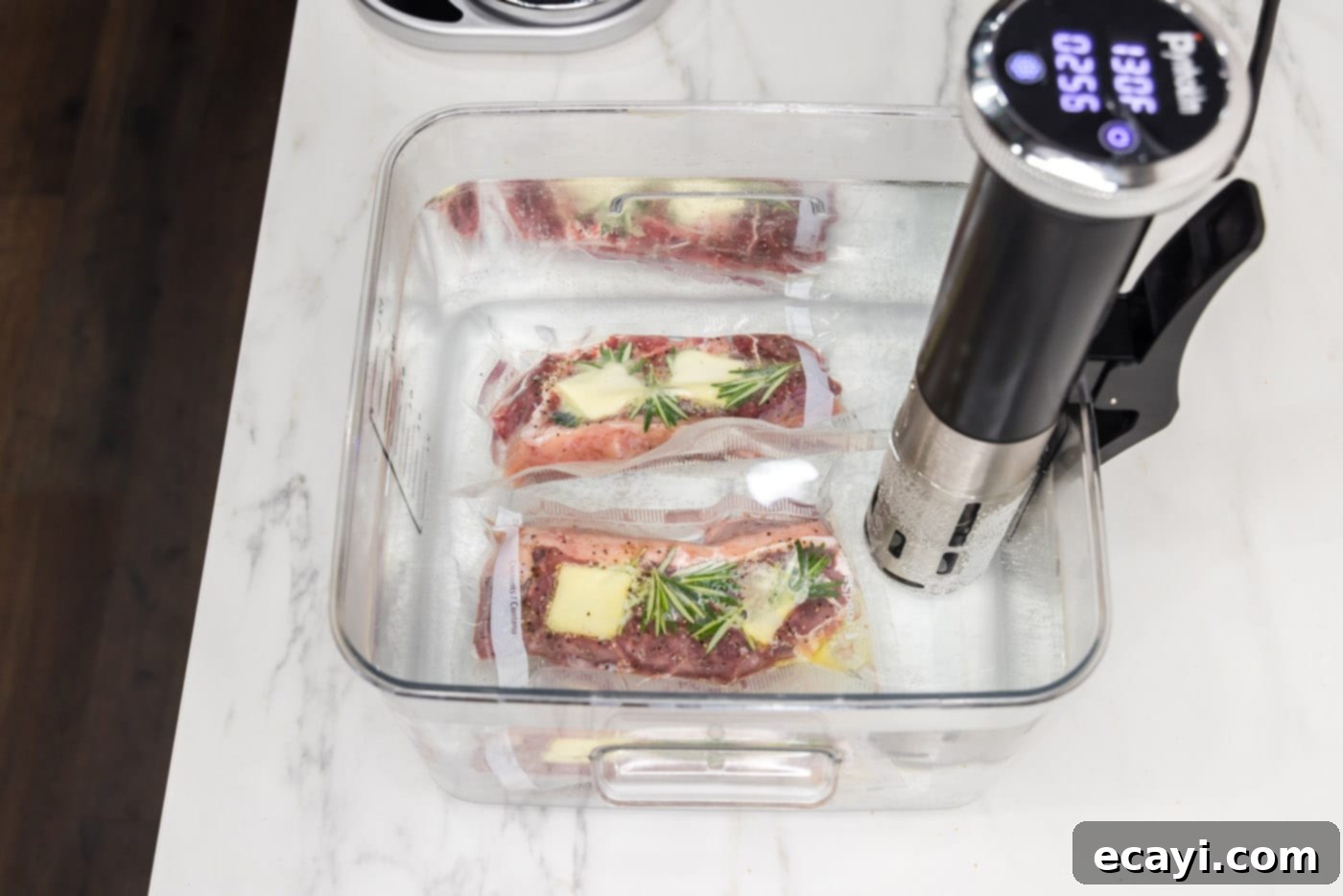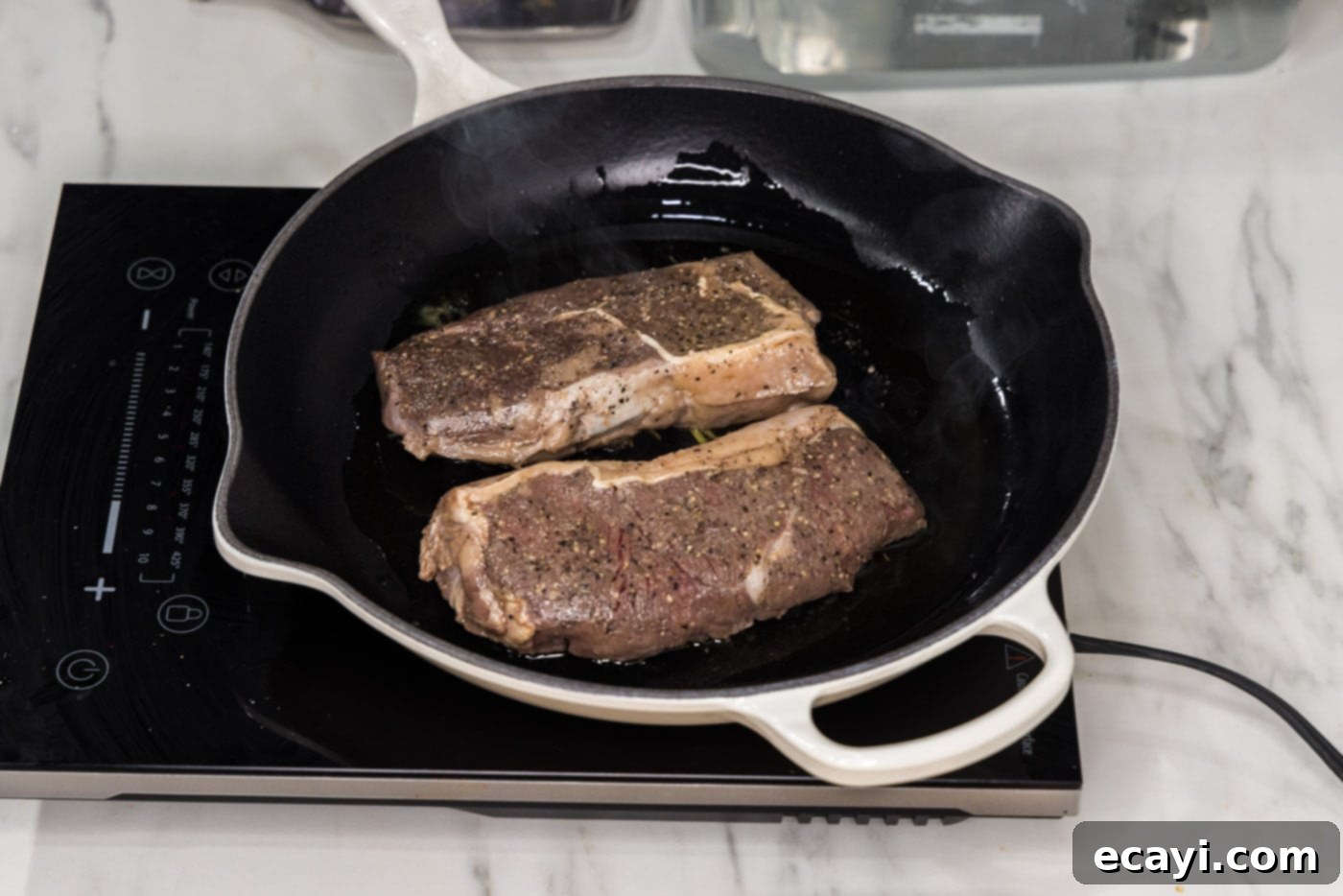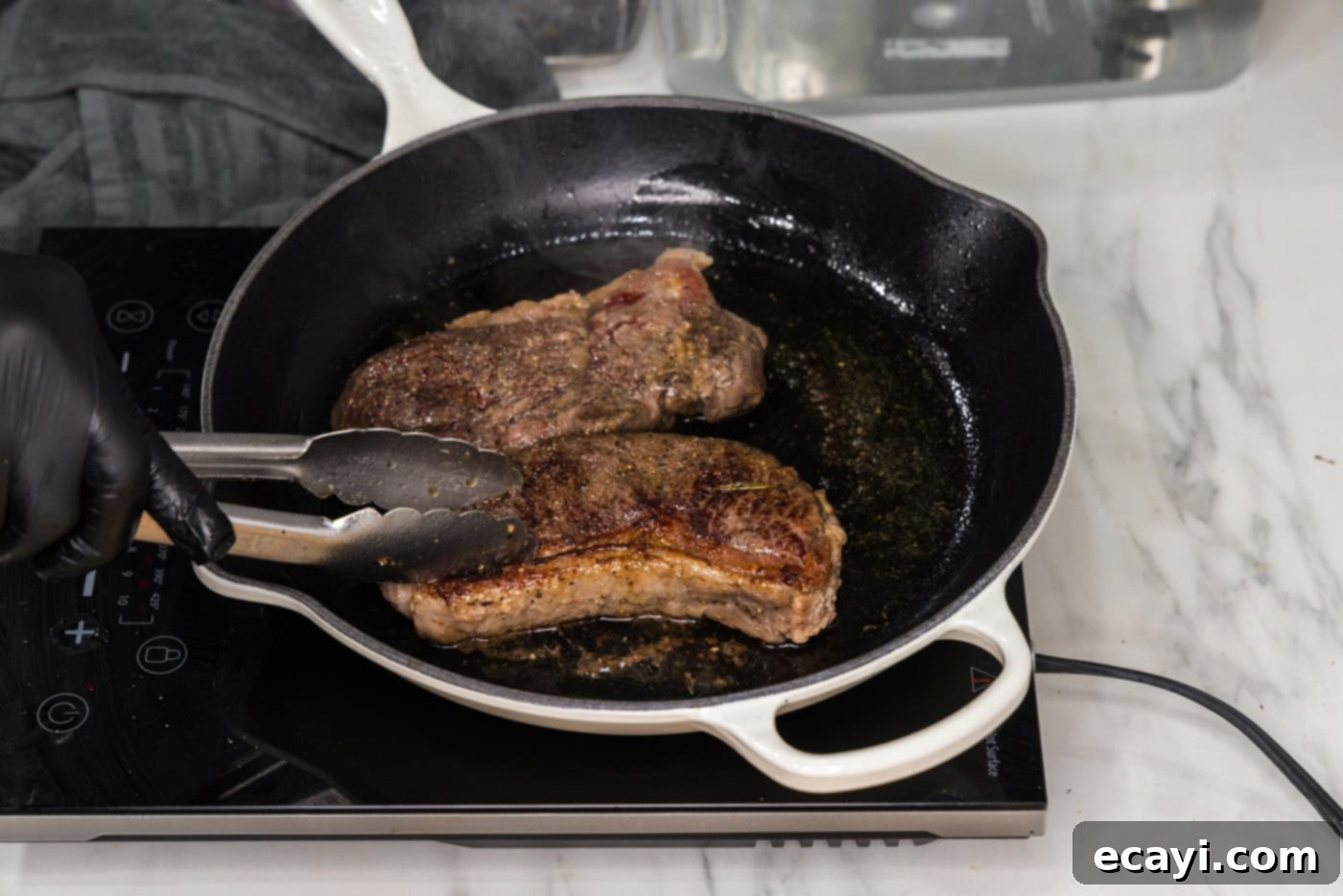The Ultimate Guide to Perfect Sous Vide Steak: Achieve Unrivaled Tenderness and Flavor
Prepare to revolutionize your steak cooking with this foolproof sous vide recipe! Imagine a steak so incredibly tender it practically melts in your mouth, consistently cooked to your preferred doneness from edge to edge, and bursting with its own concentrated, savory juices. Gone are the days of dry, unevenly cooked steak. Sous vide technology ensures every bite is packed with moisture and flavor, making this method surprisingly simple to master. Get ready to impress yourself and your guests with restaurant-quality results right in your own kitchen!
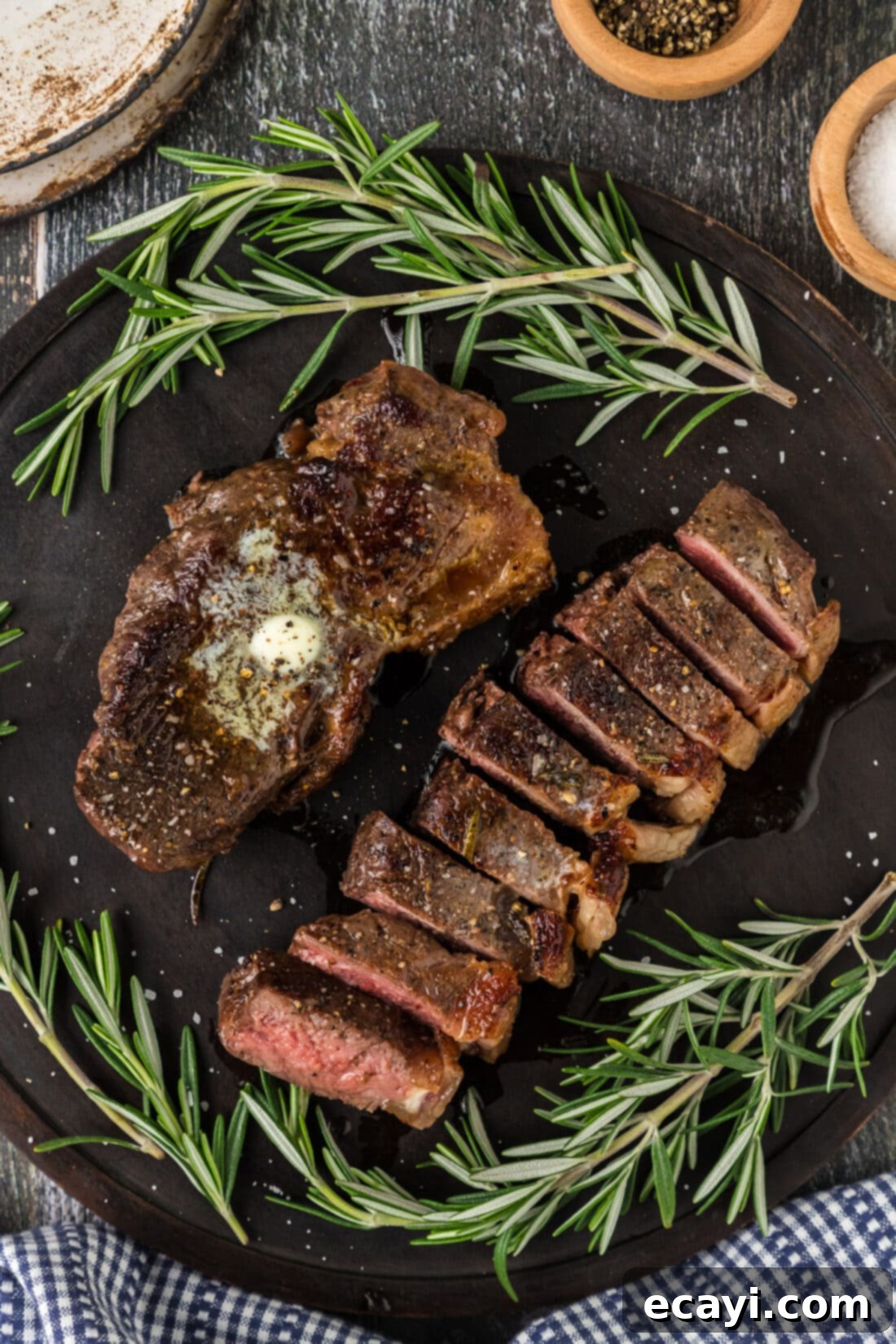
Why Sous Vide Steak is a Game Changer
Sous vide cooking stands out as a superior method for preparing steak because it delivers unparalleled precision and consistency. By cooking beef in a precisely controlled low-temperature water bath, you eliminate the guesswork and common pitfalls of traditional cooking methods like pan-searing or grilling. The result is an ultra-tender piece of beef, cooked exactly to your desired doneness from the very center to the outer edges, every single time.
The magic lies in the tight vacuum seal. When your steak is sealed in a bag and submerged in water at a constant, low temperature, it cooks gently and evenly. This process prevents moisture loss that often occurs with high-heat cooking, ensuring the steak is incredibly juicy. There’s no risk of overcooking the interior while waiting for the exterior to brown, or undercooking the center while charring the outside. Instead, the steak reaches its target temperature and stays there, allowing the muscle fibers to relax and tenderize beautifully without becoming tough.
While the sous vide bath cooks the steak to perfection internally, a quick sear afterwards is essential. This crucial step creates a delicate, caramelized crust on the outside, known as the Maillard reaction. This reaction develops complex flavors and a satisfying texture that perfectly complements the tender interior. You can achieve this with a screaming hot skillet, or for an equally effective and convenient alternative, a kitchen torch, similar to the technique we employ in our popular sous vide pork chops recipe.
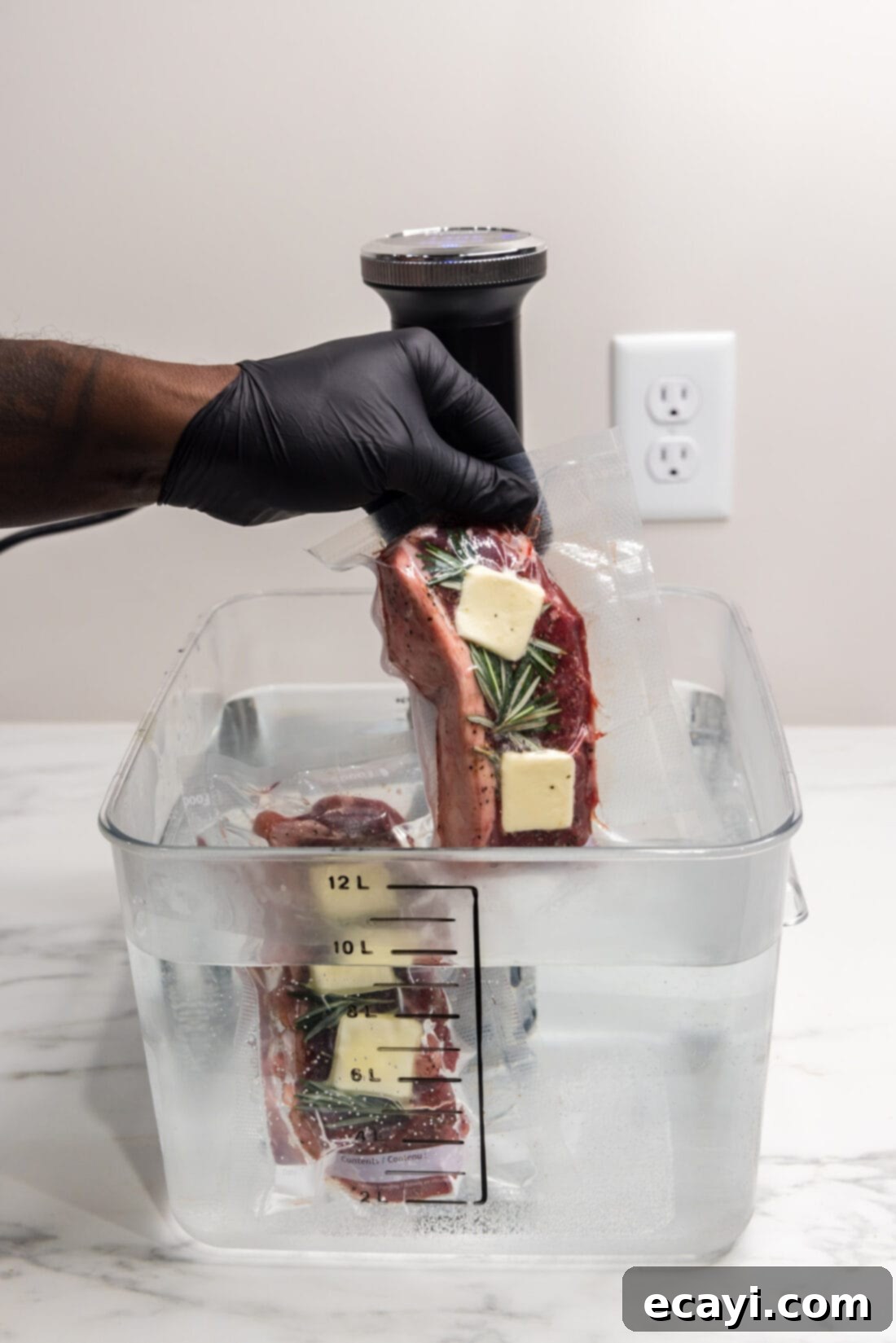
Essential Ingredients for Your Sous Vide Steak
Crafting a perfect sous vide steak doesn’t require a long list of fancy ingredients. The beauty of this method is how it enhances the natural flavors of quality beef with just a few complementary additions. Below, you’ll find the core ingredients needed for this recipe. For precise measurements and step-by-step instructions, refer to the printable recipe card located at the conclusion of this article.
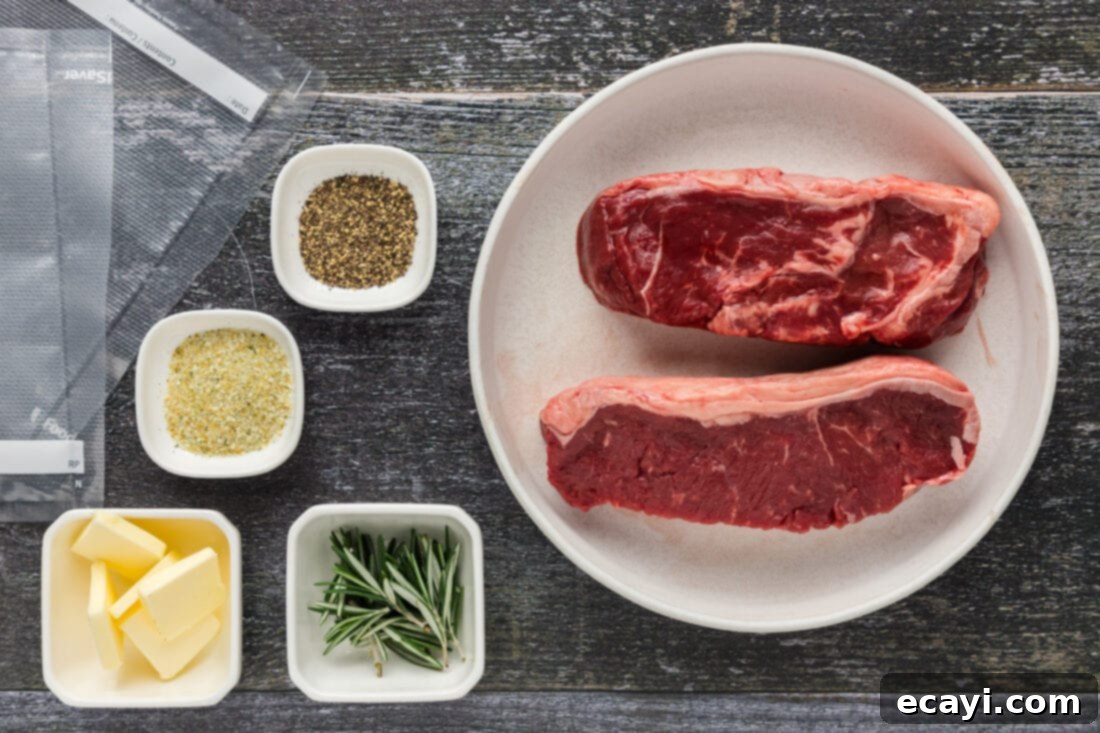
Ingredient Spotlight & Flavor Variations
Understanding your ingredients is key to elevating your sous vide steak experience. Here’s a closer look at what you’ll need and how you can customize it to your taste.
STEAK – For this recipe, we opted for two 10-ounce New York strip steaks, a fantastic choice known for its balance of tenderness and robust beefy flavor. When selecting your cut, thickness is paramount for sous vide. We highly recommend using steaks that are at least one and a half inches thick. Thicker cuts retain moisture exceptionally well during the longer sous vide cooking process and can withstand a more aggressive sear without losing their incredible juiciness. Thinner steaks, while still benefiting from sous vide, tend to lose moisture more rapidly, especially during the crucial searing phase. Other excellent cuts for sous vide include ribeye, sirloin, and even leaner options like filet mignon, which become extraordinarily tender with this method. Look for good marbling, which contributes to flavor and moisture.
ADDITIONS – The core flavor profile for a truly delicious steak often relies on simple, high-quality ingredients. Our recipe uses butter, fresh rosemary sprigs, garlic salt, and freshly ground black pepper. These classic pairings infuse the steak with aromatic depth and richness. The butter not only adds richness but also helps to conduct the flavors of the herbs and garlic into the meat. Fresh rosemary provides an earthy, piney note that complements beef beautifully. Feel free to explore other aromatic herbs like fresh thyme or oregano. For different seasoning blends, consider adding a pinch of onion powder, paprika, or a dash of Worcestershire sauce inside the bag for an extra layer of umami. Experiment with your favorite steak rub to truly personalize your meal.
Mastering the Art of Sous Vide Steak: Step-by-Step
These step-by-step photos and detailed instructions are designed to help you visualize the entire process of making this incredible sous vide steak. For a printer-friendly version of this recipe, complete with precise measurements and full instructions, please Jump to Recipe at the bottom of this post.
- First, set up your sous vide station. Fill your dedicated sous vide water container with water and secure your sous vide cooker into position. Power on the cooker and preheat the water to a precise 130°F (54°C). This temperature is ideal for achieving a perfect medium-rare doneness. Maintaining a stable water temperature is crucial for the sous vide method.
- Generously season both sides of your chosen steaks with garlic salt and freshly ground black pepper. Don’t be shy with the seasoning; a good crust of flavor will develop during the final sear.
- Next, prepare your fresh rosemary. Cut two sprigs of rosemary into 6-8 shorter pieces. Distribute these aromatic sprigs evenly across the top surface of each steak, typically 3-4 pieces per steak. The rosemary will infuse its fragrant oils into the meat during cooking.
- Slice two tablespoons of unsalted butter into 4 equal pats. Place 2 of these butter pats on top of the rosemary sprigs on each steak. The butter will melt and baste the steak, adding incredible richness and helping to distribute the rosemary flavor.
- Carefully transfer each seasoned steak, along with the rosemary and butter, into a vacuum seal bag. Ensure the steak lies flat within the bag. Using a vacuum sealer, remove as much air as possible and seal the bags shut. A proper seal is vital to prevent the bags from floating and ensure even cooking.
- Gently lower the bagged steaks into the preheated sous vide cooker. Ensure they are fully submerged in the water.
CHEF TIP – If your bags float, it indicates that air pockets remain inside the bag, preventing proper heat transfer. Carefully remove the bag, open it, reposition the steak, and re-seal to eliminate all air before placing it back in the water. You can also use weights if necessary.

- Allow the steaks to sous vide for 2 hours. This duration provides ample time for the heat to penetrate the thick cuts, ensuring uniform cooking and optimal tenderness without overcooking.
- Towards the end of the sous vide cooking time, about 10-15 minutes before the steaks are done, begin preparing for the sear. Place a large cast-iron skillet or heavy-bottomed pan over medium-high heat and add 1 tablespoon of olive oil (or another high smoke point oil like avocado or grapeseed oil).
CHEF TIP – The key to a perfect sear is a very hot pan. You want the oil to shimmer and just begin to smoke. This high heat will quickly create a beautiful crust on the steak without continuing to cook the interior, which is already at your desired doneness. Speed is essential here; you’re browning, not cooking further.
- Once the steaks have finished their sous vide bath, carefully remove the bags from the water. Cut open the bags and, using tongs, take out the steaks, discarding the cooked rosemary sprigs. Pat the steaks thoroughly dry with paper towels; this is a critical step for achieving a good sear. Place the dried steaks into the screaming hot skillet and sear each side for 60-90 seconds, or until a deep golden-brown crust forms. You can also sear the edges briefly if desired.


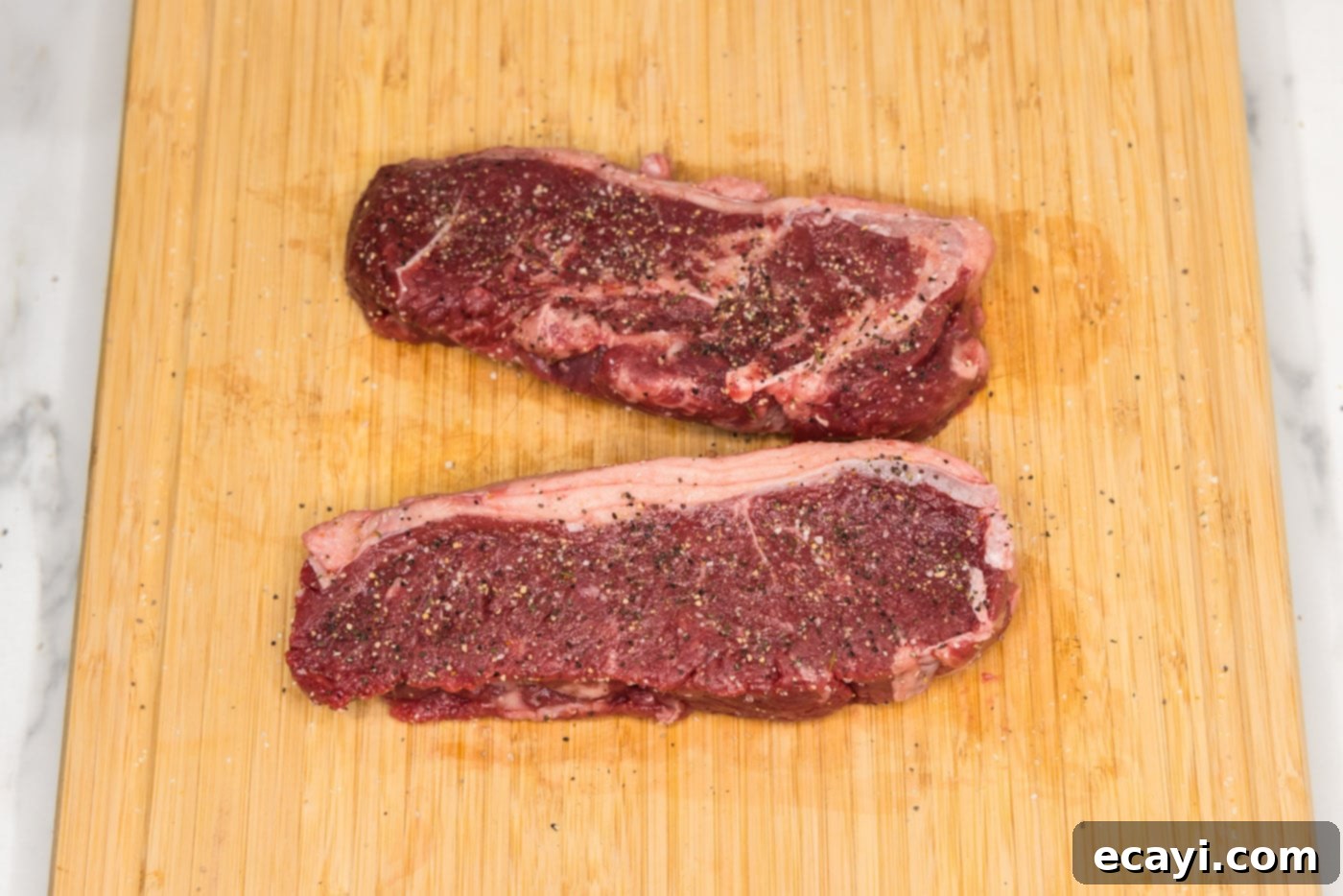
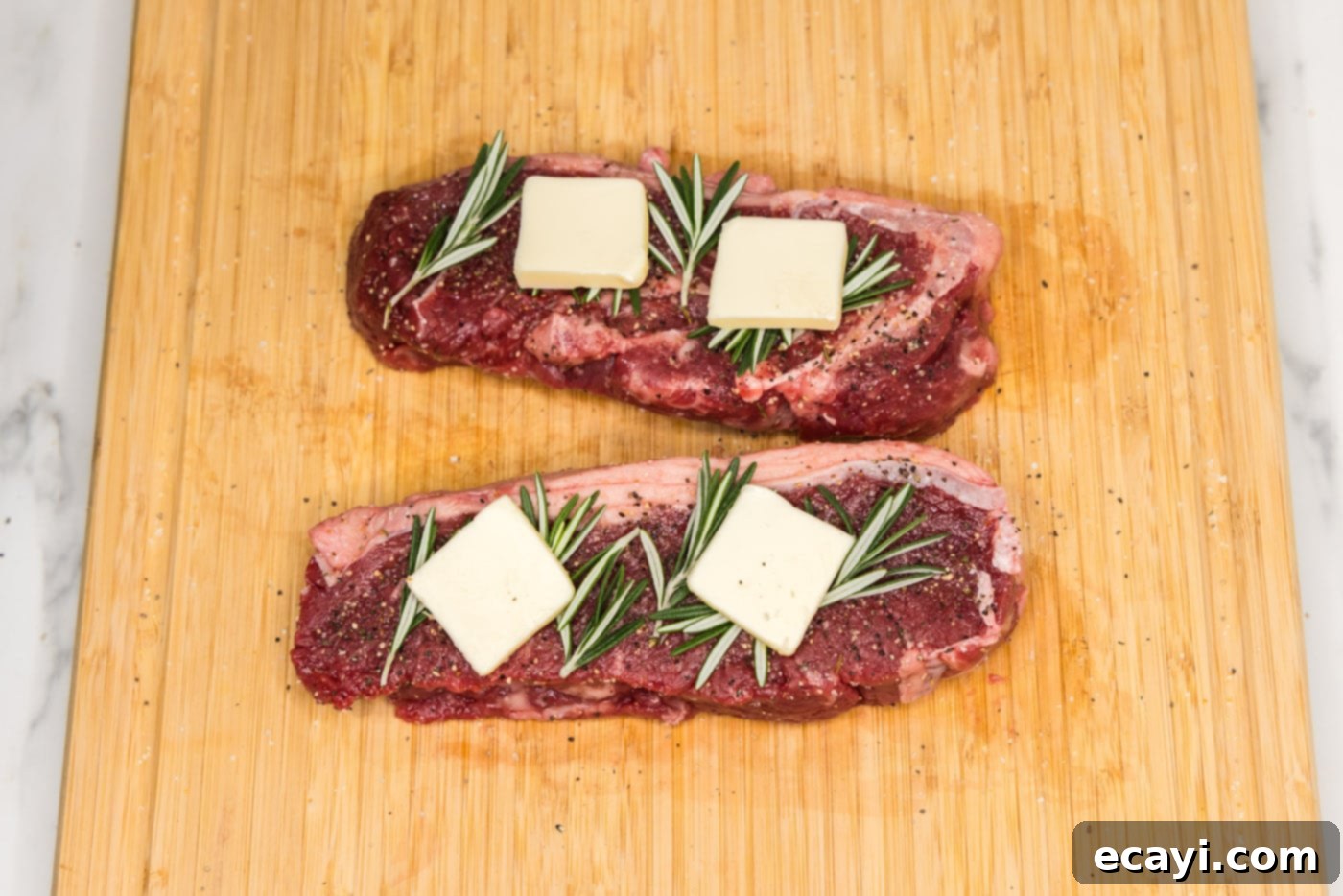
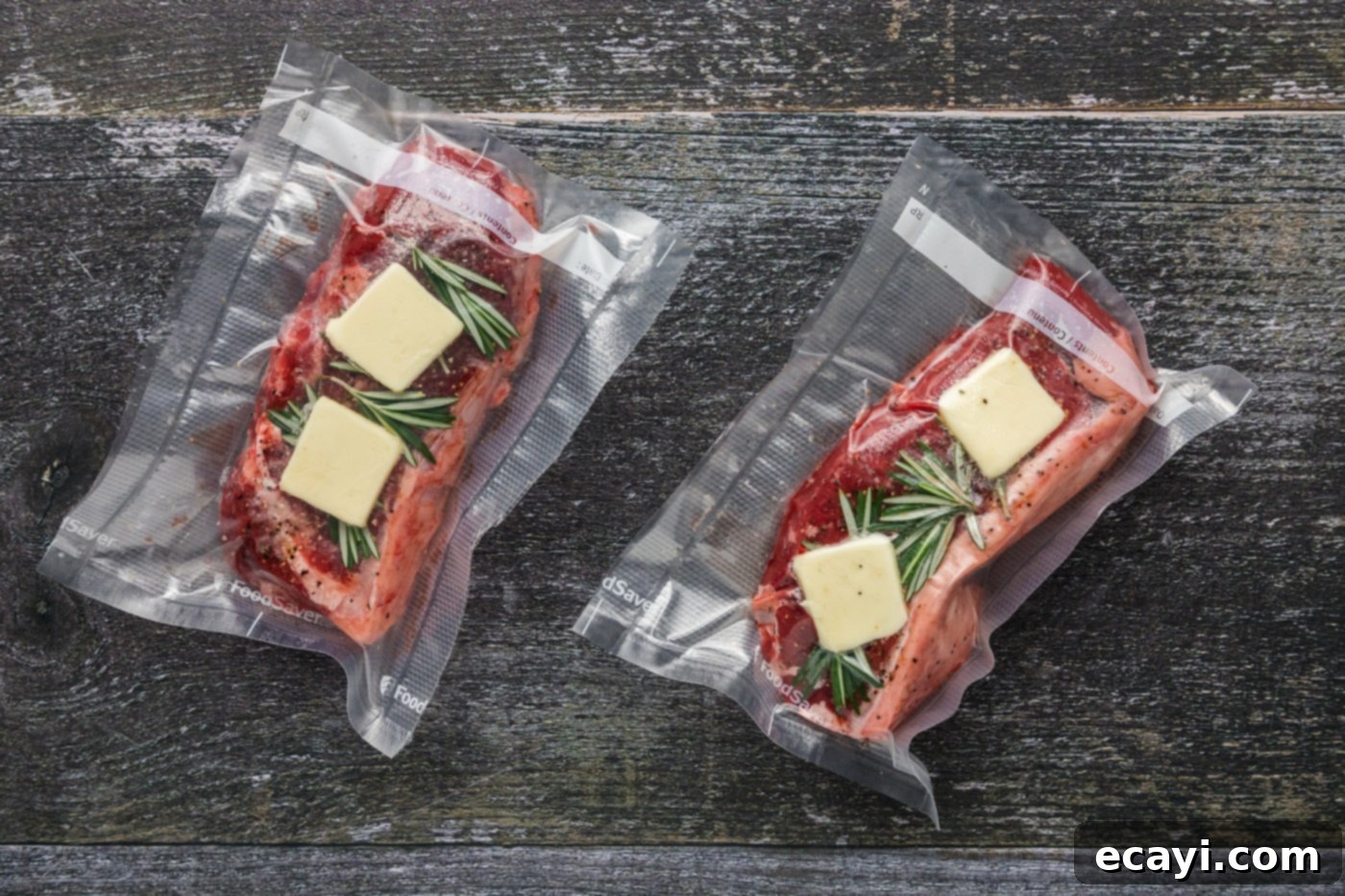
Frequently Asked Questions & Expert Tips for Sous Vide Steak
Sous vide, meaning “under vacuum” in French, is a precise cooking method where food is vacuum-sealed in a bag and then cooked in a temperature-controlled water bath. This technique ensures that food, especially meats and seafood, is cooked evenly to an exact internal temperature, resulting in perfectly tender and moist results every single time. It eliminates the risk of overcooking and locks in natural juices and flavors. Once you experience the consistency and quality of sous vide, you may find yourself using it for a wide array of dishes.
The ideal temperature depends entirely on your desired level of doneness. We prefer to sous vide our steak to a perfect medium-rare, which we achieve at 130°F (54°C). For rare steak, aim for 120-125°F (49-52°C). If you prefer a medium steak, set your sous vide cooker to 135-140°F (57-60°C). For medium-well, try 145-150°F (63-66°C), and for well-done, 155°F (68°C) or higher. Remember, the beauty of sous vide is that the steak won’t overcook beyond the set temperature, offering consistent results.
Absolutely! Sous vide is remarkably versatile and can easily handle frozen steaks. The primary adjustment you’ll need to make is to increase the cooking time. For a frozen steak, we recommend adding an extra 30 to 60 minutes to the total cooking time, depending on its thickness. This additional time allows the steak to fully thaw and then reach the target internal temperature within the water bath, ensuring it cooks just as perfectly as a fresh steak.
While a 2-hour cook time is typically sufficient for a 1.5-inch steak to reach optimal doneness and tenderness, sous vide offers some flexibility. Once the steak is fully cooked, you can actually turn off your sous vide cooker and leave the bagged steaks in the warm water for an additional 1 to 3 hours without them significantly overcooking. This can be a fantastic benefit for meal prepping or timing your dinner when guests arrive. However, we’ve found that extending the cooking time much beyond 3-4 hours can start to negatively impact the steak’s texture. The proteins can begin to break down excessively, leading to a mushy or stringy consistency rather than a pleasant tender chew. Always aim for the recommended cooking window for the best results.
Drying your steak thoroughly with paper towels before searing is a critical step that many overlook. Moisture on the surface of the steak will turn into steam in a hot pan, preventing the Maillard reaction (the browning that creates delicious flavors and a crispy crust). A dry surface allows for direct contact with the hot pan, leading to a superior, more even sear and a truly satisfying crust.
Yes, even though sous vide cooking minimizes moisture loss, it’s still a good idea to rest your steak for about 5-10 minutes after searing. While sous vide already relaxes the muscle fibers, the intense heat of the sear can still cause some contraction. Resting allows the juices to redistribute throughout the steak, resulting in a more consistently tender and juicy bite. Simply transfer the seared steak to a cutting board and loosely tent it with foil.
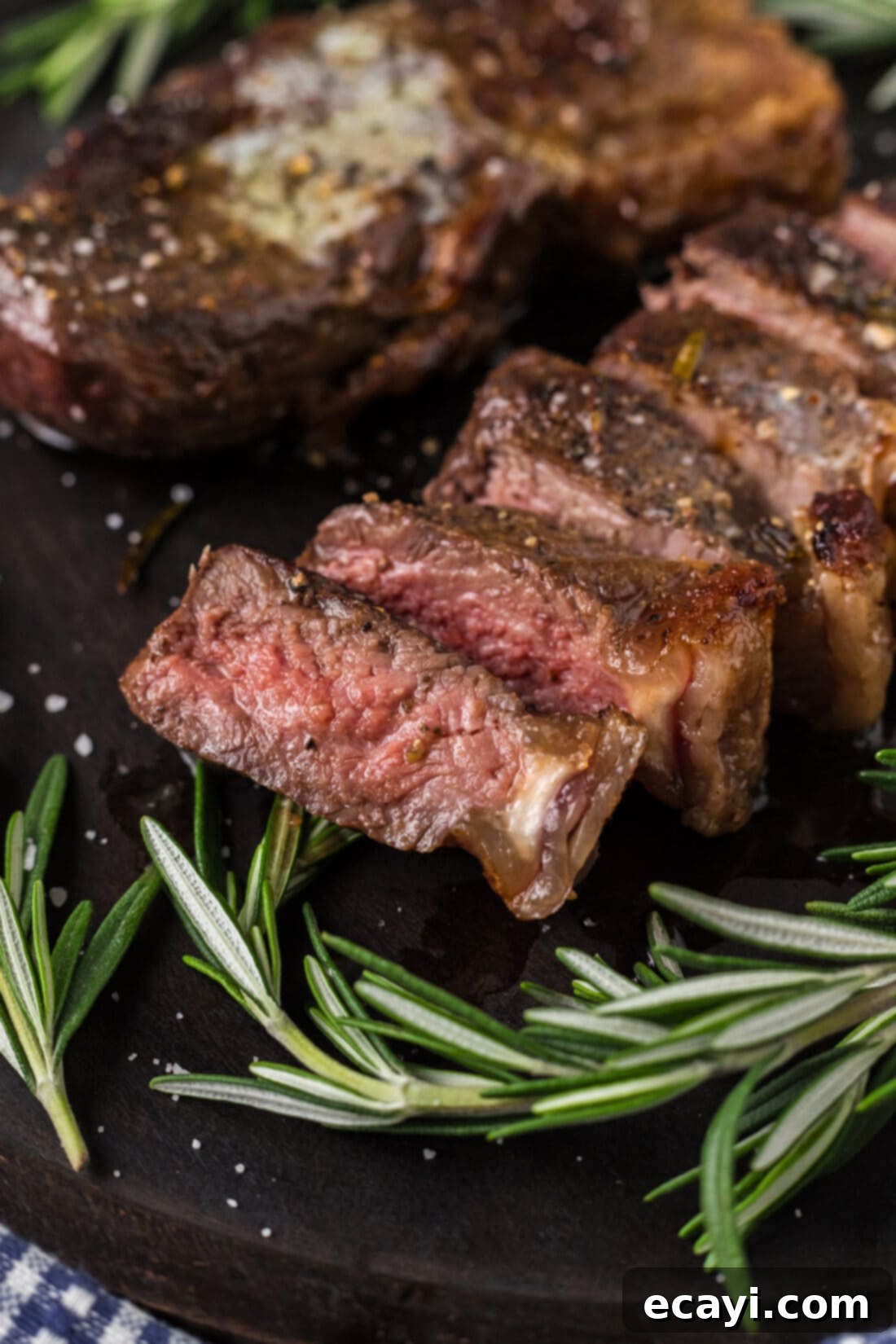
Elevate Your Meal: Delicious Serving Suggestions
A perfectly cooked sous vide steak deserves equally impressive accompaniments. Here are some classic and creative serving suggestions to round out your meal:
- Potatoes: Pair your steak with rich and creamy twice baked potatoes, fluffy mashed potatoes, crispy roasted potatoes, or even delicate pommes purée.
- Vegetables: Complement the richness of the beef with vibrant green vegetables such as roasted Brussels sprouts, tender asparagus spears, sautéed green beans with garlic, or steamed broccoli.
- Salads: A crisp and refreshing wedge salad with blue cheese dressing or a simple green salad with a zesty vinaigrette provides a lovely contrast.
- Sauces: Enhance your steak with a classic sauce like a rich béarnaise, a bright chimichurri, a savory mushroom sauce, or a decadent red wine reduction.
- Grains: For a heartier meal, serve alongside quinoa, couscous, or a wild rice pilaf.
More Steak & Sous Vide Inspirations
If you loved this sous vide steak recipe, you might enjoy exploring other ways to cook steak or other delicious sous vide dishes. Expand your culinary repertoire with these related recipes:
- Perfectly Grilled Steak
- Crispy Air Fryer Steak
- Flaky Sous Vide Salmon
- Tender Sous Vide Pork Chops
- Flavorful Flat Iron Steak
I’m passionate about cooking and baking, and I love sharing my culinary adventures and tested recipes with all of you! To make sure you never miss a new dish, I offer a convenient newsletter delivered right to your inbox every time a new recipe is posted. Simply subscribe here and start receiving your free daily recipes, tips, and inspiration!
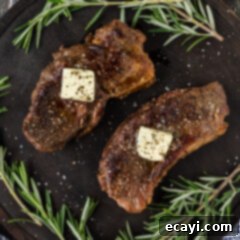
Sous Vide Steak
IMPORTANT – There are often Frequently Asked Questions within the blog post that you may find helpful. Simply scroll back up to read them for more tips and details!
Print It
Pin It
Rate It
Save ItSaved!
Ingredients
- 1 ¼ pound New York strip steak we used two 10 ounce steaks, minimum 1.5 inches thick
- garlic salt to taste, or your preferred steak seasoning
- black pepper freshly ground, to taste
- 2 sprigs fresh rosemary cut into smaller pieces
- 2 Tablespoons unsalted butter cut into 4 pats
- 1 Tablespoon olive oil or other high-smoke point oil for searing
Things You’ll Need
-
Sous vide water container
-
Sous vide cooker
-
Food saver vacuum sealer and bags
-
Large cast iron skillet or kitchen torch, for searing
Before You Begin: Key Tips for Success
- Temperature Control: We achieve a perfect medium-rare steak by setting our sous vide cooker to 130°F (54°C). For rare steak, target 120-125°F (49-52°C), and for a medium steak, aim for 135-140°F (57-60°C). Adjust according to your preference.
- Steak Thickness: For optimal tenderness and moisture retention, we highly recommend using steaks that are at least one and a half inches thick. Thicker cuts fare better during the searing process, minimizing moisture loss.
- Cooking Frozen Steak: Yes, you can sous vide frozen steak! Just remember to add an extra 30-60 minutes to the total cooking time to allow the steak to fully thaw and come to temperature in the water bath.
- Patting Dry is Crucial: Before searing, thoroughly pat your sous vide steak dry with paper towels. Any excess moisture will prevent a proper, crispy crust from forming during the sear.
- Rest Your Steak (Briefly): Even after sous vide, a short 5-10 minute rest after searing allows the juices to redistribute, ensuring every bite is as tender and flavorful as possible.
Instructions
-
Fill your sous vide water container and securely position the sous vide cooker. Set the cooker to 130°F (54°C) and allow the water to preheat completely.
-
Season both sides of the New York strip steaks generously with garlic salt and freshly ground black pepper.
-
Cut the fresh rosemary into 6-8 shorter sprigs and arrange 3-4 pieces evenly across the top of each steak.
-
Slice the unsalted butter into 4 pats. Place 2 pats on top of the rosemary on each steak.
-
Carefully place each seasoned steak into a separate vacuum seal bag and seal them shut, ensuring all air is removed.
-
Gently place the bagged steaks into the preheated sous vide water bath, ensuring they are fully submerged.
TIP – If a bag floats, it likely contains air. Remove, re-seal, or weigh it down to ensure consistent cooking.
-
Allow the steak to cook in the sous vide bath for 2 hours for a 1.5-inch thick steak, or adjust based on thickness and desired doneness.
-
About 10-15 minutes before the sous vide cooking time is complete, preheat a large cast-iron skillet over medium-high heat with 1 tablespoon of olive oil. Ensure the pan is screaming hot.
TIP – A very hot pan is essential for a quick, effective sear without overcooking the perfectly sous vide interior.
-
Remove the bags from the water. Cut them open, extract the steaks with tongs (discarding rosemary), and pat them thoroughly dry with paper towels. Immediately place the dried steaks into the hot skillet and sear each side for 60-90 seconds, until a beautiful, deep golden-brown crust forms.
Expert Tips & FAQs
- When your steak has reached its desired doneness, you can turn off the sous vide cooker and leave the bagged steaks in the water for up to 3 hours without significant further cooking. This method is excellent for flexible meal timing, allowing you to prepare ahead of guests’ arrival. However, exceeding this time frame may lead to changes in beef texture as proteins can break down too much.
- Always pat your steaks very dry before searing. Moisture inhibits the Maillard reaction, which is essential for a crispy, flavorful crust.
- For an even more intense sear, consider using a kitchen torch after the pan sear to target specific areas and achieve extra crispness.
- Resting the steak for 5-10 minutes after searing, loosely tented with foil, allows the juices to redistribute for a more tender and juicy result.
Nutrition
The recipes on this blog are tested with a conventional gas oven and gas stovetop. It’s important to note that some ovens, especially as they age, can cook and bake inconsistently. Using an inexpensive oven thermometer can assure you that your oven is truly heating to the proper temperature. If you use a toaster oven or countertop oven, please keep in mind that they may not distribute heat the same as a conventional full sized oven and you may need to adjust your cooking/baking times. In the case of recipes made with a pressure cooker, air fryer, slow cooker, or other appliance, a link to the appliances we use is listed within each respective recipe. For baking recipes where measurements are given by weight, please note that results may not be the same if cups are used instead, and we can’t guarantee success with that method.
